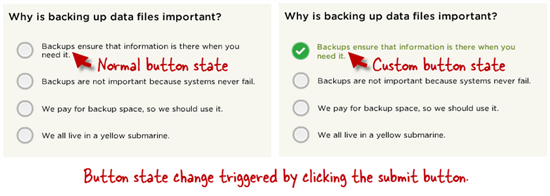Improve Your Quizzes with Immediate Feedback
Feedback is a very important part of the learning process. Obviously, it is critical for your learners to know whether they’ve answered a question correctly. Sometimes, though, you might also want them to know why their answer was right or wrong, or even which answer was correct.
Anytime you create a quiz question, Storyline gives you some default feedback for correct and incorrect answers. In most cases, these defaults are just fine. But there are times when you might want to tell your learners what the correct answer is if they didn’t answer correctly. Yes, you can always enable the Review Quiz button on your results slide so learners can review which questions they got right or wrong along with what the correct answer was; however, they can’t access that until they’ve completed the entire quiz. What if you want your learners to see the correct answer immediately after submitting their response?
Watch this video to see a few ways to give immediate correct answer feedback in your e-learning quizzes.
Textual Feedback
The first, and probably most obvious, way to give immediate feedback is to customize the feedback text for each question. This is easily done by editing the correct and incorrect feedback.
In form view, you’ll find this at the bottom of the question editor if you chose Feedback By Question, or next to each answer choice if you chose Feedback By Choice.
In slide view, visit the appropriate feedback layer to edit the corresponding feedback text for correct and/or incorrect answers.
Visual Feedback
When textual feedback isn’t sufficient, or if you just prefer to incorporate a visual aspect to your correct answer feedback, your options are virtually endless. To get you started, here are a couple of simple methods to consider.
Custom Object State
Creating a custom object state is a really easy way to visually indicate which answer is correct. In this example, I created a custom state for the button associated with the correct answer and formatted it to give a clear visual cue that it is the correct answer.
Once you have created your custom button state, all that’s left to do is add a simple trigger that changes the state of that button when your learners click the submit button. To avoid any errors, be sure to sequence this state change trigger so it comes after the one that submits the answer for scoring.
One benefit of this approach is that it works even when you choose to shuffle the answers.
Custom Feedback Layer
Another easy-to-implement approach is to work with each question’s feedback layers and customize them to suit your needs. By using layers, you’ll have a lot more options for showing your learners the correct answer along with any extra information you want them to get. This way you can include images, audio, video, characters, and more to really turn your feedback into a media-rich learning opportunity.
A word of warning: when using layers, make sure you’ve accounted for shuffled answers that will appear in a different location each time the question is presented.
These are just a few of the many ways you can provide correct answer feedback immediately after each question in your Articulate Storyline projects.
Now it’s your turn! Do you prefer immediate or delayed feedback? Do you ever give your learners the correct answers? Why or why not? Do you customize the feedback for each question or go with something more generic? Leave a comment below and share your feedback philosophy.
Post by Mike Taylor
If you want to try these yourself but don’t have Storyline, no problem. Just sign up for a fully functional, free trial. And don’t forget to post your questions and comments in the forums! We’re here to help. For more e-learning tips, examples, and downloads, follow us on Twitter.




4 Comments
Thanks for these ideas. I especially like the custom button state solution as it works when answer shuffling is enabled. The solution I've implemented in a course I'm working on is to create a separate results slide for each question slide requiring immediate feedback. I then configure each of these results slides to only calculate results for its respective question slide. It's a little tedious, but it works! Then, back on the quiz question slide itself, I insert some triggers on the Correct and Incorrect layers to both "Submit" results AND "Review" results for the question's specific results slide. These triggers are activated when the user clicks a custom button on the feedback layer (explained below). This bypasses the user ever seeing the any actual results slides... so for o... Expand